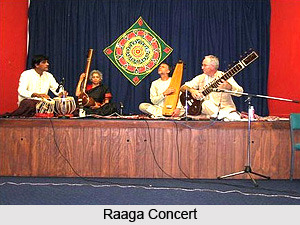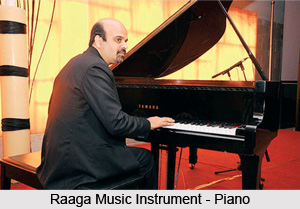 Raaga is the most important concept in Indian classical music. Raaga has been derived from the Sanskrit Language word 'Ranja', standing for an element that delights and enthralls the mind. Raaga is a combination of notes illustrated by melodic movements. There are numerous types of Raagas, like - Multani, Jaunpuri, Gaud, Sorath, Maand and Pahadi, Ahiri, Gurjari, Asavari, including several others. Raaga utilizes the entire range of the octave, starting with Aroha and ending in Avaroha, where the singer culminates the recital.
Raaga is the most important concept in Indian classical music. Raaga has been derived from the Sanskrit Language word 'Ranja', standing for an element that delights and enthralls the mind. Raaga is a combination of notes illustrated by melodic movements. There are numerous types of Raagas, like - Multani, Jaunpuri, Gaud, Sorath, Maand and Pahadi, Ahiri, Gurjari, Asavari, including several others. Raaga utilizes the entire range of the octave, starting with Aroha and ending in Avaroha, where the singer culminates the recital.Structure of Raaga
The various formations of scales become the basis of the Raaga. That is to say, the infinite permutations and combinations obtained by the arrangement of the seven Svars plus all the Srutis, provide the basis for the formation of innumerable tunes or melodies which are called the Raagas and Raaginis of Indian music.
Features of Raaga
There are certain essential features which characterize every Raaga. A Raaga must have at least five notes, and it cannot omit Sa and must also contain some form of ma or pa as well. A Raaga uses a certain selection of tones: ones that are omitted are termed "forbidden" and cannot be used without destroying the Raaga. There are many Raagas have strong tonal centers, called Vadi and Samvadi. For Gaur Sarang, for example, these are G and D respectively.
 Typically, these two notes are a fourth or a fifth apart. The Vadi-Samvadi does not substitute for the importance of the tonal center Sa in a Raaga, and do not always function the same way for each rag. Certain moods are typically associated with each Raaga, and often a time of day or season of the year. Again, Gaur Sarang is an afternoon Raaga with the moods of peace and pathos. Prescribed melodic movements that often recur, like catch phrases, identify the Raaga. In Gaur Sarang one such phrase is G R m G. There can be precise use of timbres and tonal shading, heightened by the use of microtonal pitches that vary from one rag to another, lending particular character to the rag. Raga is a combination of sounds along with "Varnas". A "Raga" is particularly the different series of notes within the octave which forms the basis of all Indian Raagas. The source of Raaga is Thala. Similarly two notes of same denomination should not come one after another. Again in a Raaga notes 'Pa' and 'Ma' cannot be put together. A Raga should have Varnas that include "Aroha" and "Abaroha" and it must also have fixed "Vadi" and a "Samavadi" note.
Typically, these two notes are a fourth or a fifth apart. The Vadi-Samvadi does not substitute for the importance of the tonal center Sa in a Raaga, and do not always function the same way for each rag. Certain moods are typically associated with each Raaga, and often a time of day or season of the year. Again, Gaur Sarang is an afternoon Raaga with the moods of peace and pathos. Prescribed melodic movements that often recur, like catch phrases, identify the Raaga. In Gaur Sarang one such phrase is G R m G. There can be precise use of timbres and tonal shading, heightened by the use of microtonal pitches that vary from one rag to another, lending particular character to the rag. Raga is a combination of sounds along with "Varnas". A "Raga" is particularly the different series of notes within the octave which forms the basis of all Indian Raagas. The source of Raaga is Thala. Similarly two notes of same denomination should not come one after another. Again in a Raaga notes 'Pa' and 'Ma' cannot be put together. A Raga should have Varnas that include "Aroha" and "Abaroha" and it must also have fixed "Vadi" and a "Samavadi" note.For more visit the link below: